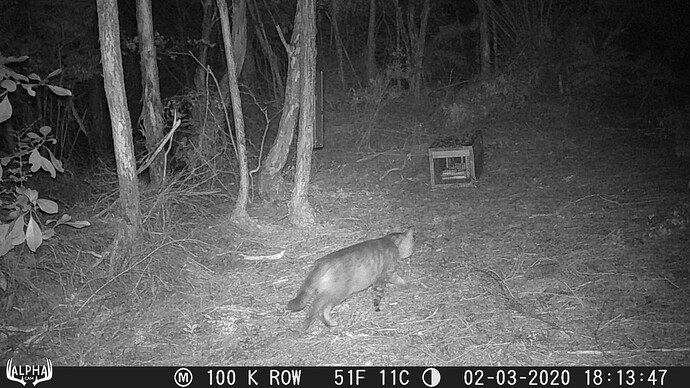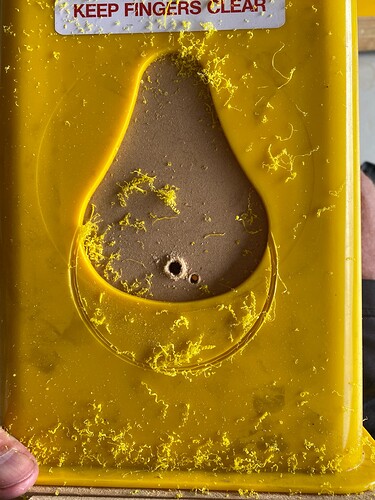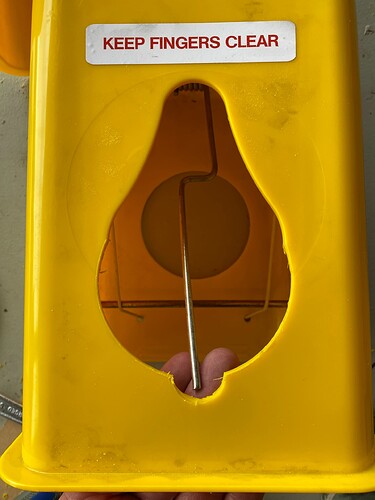We have been very successfully using fresh rabbit as cat bait in cages and timms traps, but with the warmer weather it now goes off/becomes fly blown very quickly.
Has anyone had good success with other lures that last longer?
Cheers
One thing that has worked really well in my Timms traps are thick pieces of pork fat. Predators love fat more than anything else, and its firm texture keeps it in place on the skewer. In dry weather, it basically becomes jerky, which makes it almost impossible for predators to bite off. Cut it in to pieces about 4cm x 2cm, and make an X in the middle of the fat to allow you to skewer it. Be very careful with a knife making the X’s! The next time I make a batch, I’m going to use a nail to makethe holes, because I’m worried about suffering a nasty injury.
Sometimes I’ll pickle the pork in white vinegar for 2 days to make it last longer, and to keep insects away for a while (vinegar is an excellent ant-killer). I killed 4 feral cats in 2022 with vinegar-treated fat, so either they like vinegar, or don’t mind it. The smell of vinegar acts as a curiosity lure and after a sniff, they realise that they’ve found a chunk of pure fat! Because it’s so firm, they have to really sink their teeth in to it to get a bite. I’ve killed 3 large brown rats in Timms with firm pork fat for the same reason, and it’s only a matter of time before I kill a mustelid using it.
Another treatment for flesh/fat lures is to give them a coating of Goodnature’s Meat-lover’s lure, which predators are attracted to, but insects (including blowflies and wasps) and invertebrates aren’t (where I trap, at least). The coating gives the flesh long-lasting appeal, instead of smelling nice for a little while and then starting to smell bad. As the flesh lure rots, the meat-lover’s lure helps to mask the smell, too, which is important when you’re trying to trap mustelids and cats. FYI, humans can’t smell the lure, but to predators it smells like fresh blood. It could also go on the pork pieces instead of using them as is, or pickling them in vinegar.
The only downside to using Meat-lover’s lure, is that blackbirds and song thrushes like it, so bird by-kill may increase, and/or they may get trapped in cages more often.
It’s a cheap lure to use, because 1 sachet goes a long way. I highly-recommend trying it in your snap-traps, too.
Cheers.
Goodnature’s lures are waterproof and mould-resistant, so ff you’re suffering from warm, humid weather, your flesh lures will take a long time to go mouldy. 1 lure sachet goes a long way, so it’s a cheap lure to use.
I would like to understand at what point fresh rabbit stops attracting cats. I think you are right thinking that the meat will become less attractive to a feral cat over time, but do they avoid maggoty meat. One day I’ll put some cameras on fresh rabbit and find out for sure. Perhaps somebody has tested this already?
Phil
In my experience, lures become unattractive to cats quickly, which is one of the reasons why they’re so difficult to trap. In a Timms trap at an exposed site, flesh lures can deteriorate in no time, especially during hot weather, and it won’t take long for blowflies and wasps to show up.
If there are cats around when I lure my Timms traps, the odds are very high that I’ll trap them within the first 24 hours. After 48 hours, kills are uncommon, and they’re almost always small, hungry juveniles, which can’t afford to be fussy.
I highly-recommend trying what I described in my previous post.
Good luck!
Agreed - even cooked pork fat, threaded/weaved onto the Timms spike works well and stays there. They gotta tug pretty hard to get it off and bam!
I saw this old thread and thought now is a good time to revive it with a couple of points:
- Its coming up to Christmas time - which for many means ham on the bone. Save some of the skin and use it to thread / weave onto a timms trap (or similar) to attract feral cats. Even cut some bits of pork skin into strips 200 mm long x 30 mm wide - store them in the freezer to replace older pieces of pork skin that have dried out.
We caught a recent cat on a bit of bacon threaded on a dropper bar. Ham skin lasts longer. - We have bought several chimney traps for feral cats and move them around as we see evidence of feral cats in our area - just picked up another two feral cats on a trail camera - thats been out for the last 8 weeks (picture added - note I changed the batteries in the camera but forgot to reset the date/time - user error thsi was 20 days ago!!) .
We modified the timms traps with the chimney traps in the following way:
a. cut out a larger hole on the front, with an additional cut out at the bottom so you can reload the bait dropper bar without taking the trap of the wooden slide
b. cut a hole through the back of the timms trap so the cat can get a view out through the rear of the chimney trap (often cats don’t like putting there head into a confined space. - refer to photos.
I’ve found old, dried out pieces of fat to be as effective as fresh pieces. I’d try leaving some old, dry bits on a few traps as an experiment. I’ve trapped cats using fatty lures that I didn’t think stood any chance of appealing to them, due to their age, which shows how powerful a lure fats are.
When they dry out, flesh/fat lures attach really firmly to the skewers in traps, so they stay put.
The jerky-like texture reduces interference by mice, because they’re far harder to eat than soft lures. I’ve trapped 5 brown/Norway rats in Timms lured with dry pieces of fat, because they have to sink their teeth into them, instead of just nibbling them to bits.
When they’re firm and dry, the blowflies here don’t show any interest in my lures, probably because they’re too dry to lay eggs in. Where I live, fresh lures are ruined by blowfly maggots in no time, so there’s a very small window for cats to find my Timms with quality lures in them. Dry, high-fat lures are effective, long-term, low-maintenance lures.
Pieces of ham skin are great lures in every trap, and ham bones are great in DoC tunnels. In addition to their strong, attractive scent, they’re a long-lasting lure, because rats use bones to sharpen their teeth, and they will chew through bones to eat the marrow. The fact that ham bones are a bit salty, adds to their appeal. It isn’t a big deal if predators too small to fire the DoC trap(s) eat the scraps of ham, because the bone is still very attractive to rats. The sights and smells of rodent activity are also appealing to mustelids.
Regarding the trap modifications, which tool did you use to enlarge the entrance?
Predators might be able to eat lures from the hole on the back, so making a barrier of some kind would be a good idea, like some strong mesh. A piece of see-through plastic might be even better. Part of a Coke bottle?
Thanks for the excellent sharing of experiences and knowledge on these threads. I thought I may add info based on a some of my experiences.
- Envrotools produce a trap called a Flipping Kitty which has been developed for feral cats. I have seen these traps deployed in sanctuaries protecting birds such as takahe. They are grey and have holes in the back so a cat can see through.
- I have on occassions used baits which are completely new yet related to what the cats may be eating. So baits such as smoked kahawai and even a piklet with butter both were effetive for feral cats when used in a SA2. The key being for me to follow Cam Speedy’s advice of 1/3 bait (half a kahawai head) in the trap, 1/3 smeared on the ramp and 1/3 smeared leading to the base of the ramp from 3 - 7 metres out. Personally I prefer to smear bait as well as leave pieces on the ground because birds etc can take bait pieces away.
- I am guessing for cats, as the apex predator, they may want to investigate something new in their territory which has the potential of being food. Only a guess though.
- Where allowed I also like to defend feral cat, possum and DOC traps from mouse predation and deploy a Philproof within say 5 metres of a trap. Brodi can be pulsed through the bait stations when appropriate. The reason I deploy bait stations nearby is to help ensure the baits in the traps remain there as long as possible.
Any way just some thoughts. Cheers


